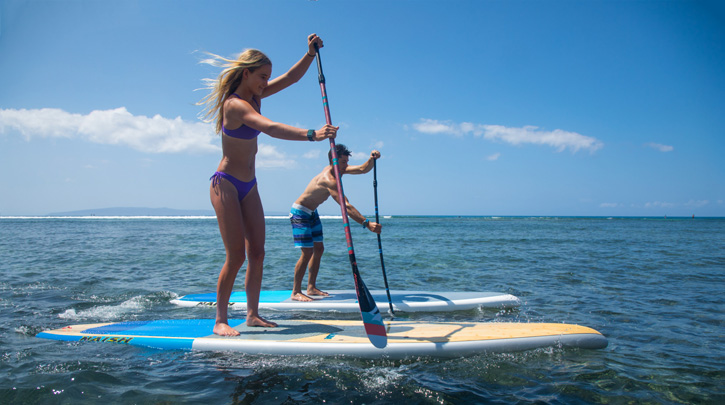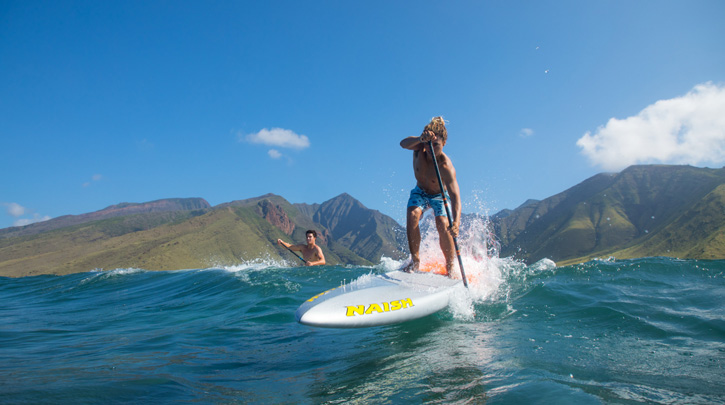
Even better, it doesn’t hurt when you fall off!
“The full breadth of versatility of the Stand Up Paddleboard is still being realised.”
Imagine the sport of cycling starting off in Down Hill racing. After a whilst devotees realise that there are just so many other ways to enjoy the sport.
With Stand Up Paddle there is surfing, racing, down-winders, cross training, yoga, family outings to adventures exploring any rivers, lake, estuary or coastline.
There is nothing like exploring your favourite patch of water on a SUP.
Touring and racing boards are more specialised than all-round Stand Up Paddleboards. We specialise in both. Read more about the different types of boards here or give us a call.

Downwinders: 20 knot days aren’t just for windsurfers! All you need is two people with two cars, and you’ve got yourself a downwinder! Simply meet at the downwind location, leave a car there – and bring both of you and your gear to a point of your choice UPWIND of where you started. You could get blown all the way back to your car without paddling, but that’s just lazy! Put in a few strokes here and there to catch runners or little waves, and surf your merry way back downwind. Make sure you wear a leg rope, because your board might blow away faster than you can swim! Use common sense, and have a PFD if you think you may enter offshore/exposed waters. Once you’ve done a few downwinders to get your sea legs, go on longer missions, with more people, in MORE wind – to make up an EPIC downwinder.
This video, more than any other captures the thrills of catching ocean swells and runners on a long SUP with a decent wind behind you.
Playing in the open ocean does have it’s risks so be aware of the potential dangers before going out.
1. Leg Ropes – Use standard surfboard leg ropes (4-6mm is fine so there’s not too much drag) and attach them to the leach plug at the tail. If you fall off in a big downwind and get separated from your board it can end up cart wheeling away from you and you will be in a bit of trouble.
2. Visibility – We also made both of our boards as brightly coloured as possible. I would advise at least making some part of your board (eg Nose and tail) as bright as you can, just in case you need rescuing. I used safety orange but Day-Glo orange is the way to go for sure. As my board is Orange all over I will be spraying a large black “V” on the bottom deck which will double up as a V sheet. We also spray painted the back of our paddle blades orange which can then be used to attract attention (again use Day-Glo orange). When any paddle got too far ahead of the other (we kept this to a minimum 100m) the front paddler would kneel down with the paddle upright. The orange paddle blade faced the lagging paddler and doubled up as a mini sail. Our clothing was also pretty bright and we will use high reflective attachments next time. It’s no good if the rescue people cannot see you. So whatever you come up with make it as easy for these guys to find you.
3. Rescue Services – We contacted all of the relevant VMR (Volunteer Marine Rescue) agencies ahead of our paddle and discussed our route plan with them. On the day we phoned in every few hours (on our mobiles) so that they could monitor our progress. They were very helpful and appreciative of the fact that we tried to make their job of rescuing us as easy as possible.
4. Communication – We had mobile phones on both of the Jet Skis, our land support crew and also 1 for the paddlers. We would probably carry 1 mobile each next time as well as get waterproof VHS radios. We also carried whistles for attracting attention. I was going to bring some kind of high reflective surface (mirror) for attracting attention but did not get around to it – next time for sure.
5. EPIRB – We did not take these (why are they so expensive?) as we did not expect to be far enough offshore to need them. We will probably need to start using them in future. The local law is that you have to use these if more than 2 nautical miles from shore. Our max distance offshore was about 5km which is just on the limit.
6. Support Crews – We had 2 jet skis and 1 land based vehicle. The Jet Skis were very handy as we did not want to have to carry our extra fluids that we figured we would need. They also helped us keep an eye on unwanted friends from the deep. We had experimented with a shark shield on Dales board before but we have not quite worked this out properly. Once we get these worked out we will probably start using these on long paddles through sharky waters.
7. Medical Kit – This is a must have item. Ours included a tourniquet, trauma packs, bandages, a safety blanket, gloves, pain killers and anti histamine.
8. Flares – I would also advise each paddler to carry at least 1 flare (rocket or smoke) but 2 is better. If anyone gets separated from the group and they run into trouble they need to be able to get spotted by the rest of the group or rescue people.
9. Spare Paddle – I fell near Cook Island and actually broke my paddle handle (with about 20km to go). As we had support Jet Skis with us they carried the spare paddle, which was nice for us.
10. Tool kit – This contained a few important tools that could come in handy out to sea, including duck tape. We actually duck taped my broken paddle handle back together and I could use it rather than the spare.
11. Fluids – You should have at least a 3ltr backpack which should last you 6hrs of paddling (1/2 litres per hour). We carried 3 x 3 litre packs each. If you don’t like the back pack type get yourself the bum bag type. Dale and I used different liquids as it is important to find out what works for you. I have been using Endura Electrolyte mix which definitely works for me. I also use Endura Optimizer for recovery (pre and post paddles) assistance.
12. Skins – We both used long leg and long arm “skins”. These are really good for paddling and double up as sun protection clothing. The long legs keep the legs warm and work like a charm. I used the white “Ice” top which is great for keeping you cool (which helps in the hot climate up here) and keeps the sun out.
13. Sun Protection – We used total block out zinc on all of our exposed parts, especially the tops of our feet and face. We tried surfing booties for our feet but did not like them. If we do not find a better system we will stick to the zinc.” “…. this clip hopefully shows that we never allowed ourselves to get seperated by more than around 100m during the whole trip. As soon as Dale fell I went onto my knees and put the paddle blade straight up into the air. This would let Dale see where I was even though I might have been down a trough. It also enabled me to keep on moving forward using the wind on the blade face as a small sail.
” ‘Mikeman’ is experienced with downwinders, and posted the above tips & tricks on Seabreeze to help everybody out:
The possibilities are endless on a SUP. Even whitewater SUP is taking off!